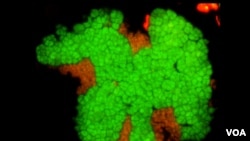A new study finds that tiny microbes inside rocks in the deep ocean are munching on methane.
Methane is a powerful greenhouse gas. Although it doesn’t remain in the atmosphere as long as carbon dioxide, while it's there, it is more than 80 times more potent than CO2. Methane is emitted by natural sources such as wetlands, as a byproduct of raising livestock, as well as from human activities, such as leakage from natural gas systems. It also is abundant in the ocean - largely in frozen reservoirs, but also seeping from deep within the earth's interior, through cracks in the ocean floor.
Little of that gas reaches the atmosphere, thanks to methane-eating microbes that live in seabed sediments near methane vents in the deep ocean.
Methane seeps from deep water vents
California Institute of Technology geo-biologist Victoria Orphan studies the habits of those microbes. She said they are adapted to survive in this extreme environment.
“These organisms would be able to extract energy from methane using sulfate found in sea water rather than oxygen and as an end product would produce hydrogen sulfide. So this is sort of that rotten egg smell. And also, as another by-product, these organisms would produce carbonate, sort of like the pavement you see on the sidewalk,” she said.
Over time, that calcium carbonate forms towering rocky seamounts adjacent to the methane seeps. Orphan hypothesized that those outcroppings also harbored life, so she hitched a ride on a submersible down 800 meters to the sea floor to prove it.
Rocks show signs of life
During four expeditions, between 2006 and 2011, samples of the sediment and the seamounts were retrieved from the near-freezing water. Orphan said the rock samples confirmed her theory.
“These are not just simply end products of methane oxidation, but they actually maintain a viable community of microorganisms living inside the pore spaces of the rock that turns out are still capable of consuming methane,” she said.
Her analysis showed that the seamount microbes did so at a slower rate than their methane-munching cousins in the sediment, however, because not as much methane seeps through the tiny fissures in the rock.
“But, considering that the volume of rock that is available to colonize down in these deep-sea environments, it still can be a significant potential source of methane consumption," said Orphan. "So instead of just considering this just a process that is going on in sediments, we have this whole other expansive habitat to look at as a sink for methane over time.”
Deep-sea microbes keep methane from escaping ocean
Writing in the journal Nature Communications, Orphan says the abundance of these tiny organisms - both in sediment and in rock - explains how the microbes can put a lid on methane in the world's oceans so it doesn’t make it through the water column to the atmosphere. And, she adds, the diversity of worms, crabs and other creatures crawling around the rocks consuming the microbes, may indicate a dynamic - previously unknown - ecosystem.










